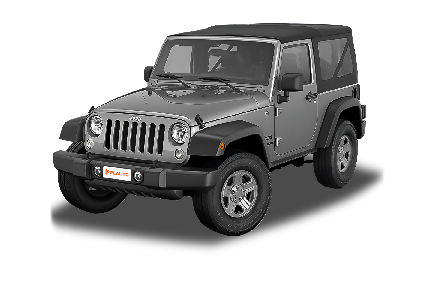Q
What is the capacity of fuel tank in a Jeep Wrangler?
The fuel tank capacity of a Jeep Wrangler may vary depending on the model and year. Typically, its fuel tank capacity is about 20 gallons.
Special Disclaimer: This content is published by users and does not represent the views or position of PCauto.
Related Q&A
Q
How many gallons of fuel can a Jeep Wrangler hold?
The fuel tank capacity of the Jeep Wrangler varies depending on the model and year. Typically, its fuel tank capacity is approximately 20 gallons.
Q
How to recline the front seats of Jeep Wrangler?
The Jeep Wrangler's front seat folding mechanism typically features adjustment buttons or levers located on the side of the seat. Look for buttons or levers marked with a seat shape and an arrow indicating direction. Simply follow the indicated direction to fold the seat down. While the specifics may vary slightly for different model years and trims, the general operation remains similar.
Q
How deep can a Jeep Wrangler wade through?
The water fording depth of a Jeep Wrangler typically depends on several factors, including the vehicle's configuration, modifications, and driving skills. Generally speaking, a common, unmodified Jeep Wrangler can safely wade through approximately 760 millimeters (30 inches) of water. However, it's crucial to adhere to the manufacturer's specified limits to avoid damaging the vehicle. When fording water, drivers should also carefully assess the flow conditions and the underwater terrain to ensure safe passage.
Q
How many miles can Jeep Wrangler run?
The range of the Jeep Wrangler in Malaysia is affected by various factors such as driving habits, road conditions, vehicle configuration, and the type of fuel used. Generally speaking, its full tank driving range is roughly between 400 and 600 miles. However, it should be noted that this is only a rough range.
Q
What is the difference among models of Jeep Wrangler?
The Jeep Wrangler in Malaysia is primarily available in three variants: Sport, Sahara, and Rubicon. The Sport serves as the base model, equipped with a 3.6L V6 engine (285 horsepower) and a standard four-wheel-drive system, making it suitable for daily use. The Sahara adds luxurious features such as leather seats and a power sunroof. At the top of the lineup, the Rubicon is specifically designed for off-road enthusiasts, featuring a Rock-Trac transfer case, front and rear locking differentials, and electronic sway bar disconnect, along with a higher ground clearance, making it the ultimate choice for serious off-roading.
Different models also vary in chassis strength and suspension systems for off-road capabilities. It is advisable to choose based on your usage needs; the Sport or Sahara is sufficient for city commuting, while the Rubicon is better suited for tackling challenging terrains.
Q
How to open the hood of Jeep Wrangler ?
The steps to open the hood of a Jeep Wrangler are usually as follows: First, find the hood release handle located inside the cabin, usually near the driver's foot area, and pull the release handle. Then walk to the front of the vehicle, find the gap near the emblem or grille of the hood, stretch your fingers in to toggle the internal safety latch, and lift the hood up. However, you need to pay attention to the force and safety during operation.
Q
How to turn on the fog lights of Jeep Wrangler?
To turn on the fog lights of Jeep Wrangler, you can follow these steps: firstly, locate the light control stalk, typically positioned on the left side of the steering column with a distinct symbol of fog lights. Then, rotate or push the fog light switch on the stalk to the accurate position to turn them on. Note that the exact operation may vary depending on the model year and specific vehicle configuration.
Q
Which coolant is suitable for the Jeep Wrangler?
Regarding coolant selection for Jeep Wrangler in Malaysia, it's generally recommended to use high-quality ethylene glycol-based coolant that meets the vehicle manufacturer's specifications and requirements. Common brands such as Mobil and Shell offer suitable products. However, ensure the coolant has appropriate boiling and freezing points to accommodate Malaysia's climate conditions. Additionally, pay attention to the coolant's service life and replacement interval, typically every 2 to 5 years or based on the vehicle's mileage.
Q
What are the different models of Jeep Wrangler?
Common models of Jeep Wrangler in Malaysia include the Sport, Sahara, and Rubicon. The Sport version focuses on practicality, with relatively simple and basic configuration. The Sahara enhances comfort and adds some off-road assistance features. Boasting the oustanding performance of off-road, the Rubicon comes equipped with a more robust 4WD system and professional-grade off-road gear. These models differ in exterior details, interior features, and pricing to cater to diverse consumer preferences.
Q
What's the weight of Jeep Wrangler?
The weight of the Jeep Wrangler can vary depending on the specific configuration and model. Generally speaking, the weight of common versions is around 1900 kilograms.
Latest Q&A
Q
What is the PCD Size of Honda Civic Type R?
The PCD (Pitch Circle Diameter) of the Honda Civic Type R is 5x120. This means its wheels have 5 bolt holes, evenly spaced around a circle with a diameter of 120 millimeters. This specification is similar to many high - performance vehicles and is suitable for pairing with wide wheels and high - performance tires to enhance handling.
For Malaysian car owners, understanding the PCD size is very important. When replacing wheels or upgrading the braking system, it's essential to ensure that the PCD of the new components matches the original factory specifications. Otherwise, adapter flanges may be required, which can affect safety and may not comply with local regulations.
In addition, the center bore diameter of the Civic Type R's wheels is 64.1 millimeters, and the offset (ET) usually ranges from 45 to 55. These figures also influence the selection and installation of wheels.
If you're planning to modify your vehicle, it's advisable to choose certified wheel brands and consult professional technicians to ensure compliance with the requirements of JKR and JPJ while maintaining the vehicle's original performance and safety standards.
Q
What is the Gearbox Type of Honda Civic Type R?
The Honda Civic Type R is equipped with a 6-speed manual transmission. This transmission is specifically tuned for high-performance driving, featuring short-throw shifting and precise clutch feedback. It can fully unleash the power of its 2.0-liter VTEC turbocharged engine, making it an ideal choice for Malaysian drivers who seek driving pleasure.
A manual transmission allows drivers to be more directly involved in power transfer. Moreover, techniques like rev-matching during downshifting can enhance cornering performance. The Type R's transmission comes with a rev-matching function, which reduces jerking during gear changes and is more newbie-friendly.
It's worth noting that the manual transmission still has a loyal following in Malaysia's driving culture, especially among performance car enthusiasts. This is because it offers a purer driving experience. Additionally, the Type R's transmission is designed with daily durability in mind. For example, the synchronizers and gear materials are strengthened to suit the diverse local road conditions.
When compared with other hot hatches in the same class, the Type R's manual setup emphasizes the sense of driving engagement rather than simply chasing shift speed. This distinctive positioning makes it stand out in the Malaysian market.
Q
What Engine is Used in Honda Civic Type R?
The Honda Civic Type R is powered by a 2.0-liter turbocharged four-cylinder gasoline engine with the code K20C1. This engine is well - known for its high performance and reliability. It can deliver a maximum power of 320 horsepower and a peak torque of 400 Nm. Paired with a 6 - speed manual transmission, it offers an extremely fun - to - drive handling experience.
This engine features VTEC (Variable Valve Timing and Lift Electronic Control) technology and is combined with a turbocharging system. This ensures strong torque output at low revs and powerful performance at high revs, making it highly suitable for Malaysia's winding roads and urban driving conditions.
Notably, this engine has undergone special tuning to meet the dual requirements of the Type R model for both track and daily driving, while still maintaining Honda's consistent fuel efficiency.
For Malaysian car enthusiasts, the Civic Type R is not just a high - performance front - wheel - drive hot hatch. It is also an outstanding example of Honda's engineering. Its engine design takes into account both durability and the thrill of driving, making it a perfect choice for local car owners who love to drive.
Q
How Much CC Does Honda Civic Type R Discharge?
As a high-performance hatchback beloved by Malaysian car enthusiasts, the Honda Civic Type R is powered by a 2.0-liter four-cylinder turbocharged gasoline engine with a specific displacement of 1996cc (commonly referred to as 2000cc or 2.0L). This engine can churn out over 300 horsepower in both the FK8 and FL5 generations. Paired with a 6-speed manual transmission, it offers drivers an extremely enjoyable driving experience. For the Malaysian market, the engine displacement of the Civic Type R falls within the range familiar to local consumers. It can not only meet the needs of daily driving but also showcase its high-performance potential on track days.
It's worth noting that although the displacement remains the same, there are upgrades in turbocharging technology, fuel injection systems, and engine tuning for different generations of the Type R. For example, the FL5 version has optimized turbo response and cooling efficiency, which is why it can produce higher horsepower while maintaining the same displacement.
In addition, when Malaysian car enthusiasts choose performance cars, besides paying attention to displacement, they also comprehensively consider the vehicle's suspension tuning, aerodynamic design, and electronic assistance systems. The Civic Type R also performs excellently in these aspects. In particular, its front-wheel-drive chassis tuning is a benchmark in its class and doesn't lose out even when competing with rear-wheel-drive models with larger displacements.
Q
What is the Reslae Value of Honda Civic Type R?
As a high-performance front-wheel-drive sports car, the Honda Civic Type R has shown excellent resale value in the Malaysian used car market. Especially for models in good condition with low mileage, the residual value rate usually remains around 60% to 70% after three years. This is due to the reputation of the Type R series in the sports car field, the scarcity of limited supply, and the recognition of the Honda brand in the local market.
The key factors affecting its second-hand price include the vehicle's maintenance record (it is recommended to keep complete 4S shop repair receipts), whether it has been modified (the original factory state is more preferred), and the body color (classic color schemes such as Championship White hold their value better). At the same time, it should be noted that the FK2 generation before 2017 has less inventory in the right-hand drive market, so it actually has more collection premium space than the subsequent FK8 generation.
For potential buyers, it is recommended to purchase through the certified used car channel on the official website of Honda Malaysia or professional sports car dealers. These channels usually provide additional warranty services. Owners who love track driving need to pay special attention to checking the heat dissipation system and clutch wear. Because the high-rev turbo engine of the Type R places a large load on the cooling system after intense driving, these details will directly affect the valuation when reselling.
View More


















Pros
Cons